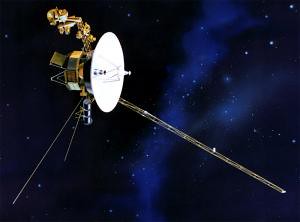Voyager, 30 Years On… and On…
Billions of miles away from earth, way past the edge of our solar system, Voyager 1 is quietly (we assume) celebrating its pearl anniversary this week.

Space.com reminds us of the two Voyagers’ origins:
Voyager 2 launched on Aug. 20, 1977, and Voyager 1 launched on Sept. 5, 1977. Both spacecraft continue to return information from distances more than three times farther away than Pluto, where the sun’s outer heliosphere meets the boundary of interstellar space…
Voyager 1 currently is the farthest human-made object at a distance from the sun of about 9.7 billion miles (15.6 billion kilometers). Voyager 2 is about 7.8 billion miles (12.6 billion kilometers).
Originally designed as a four-year mission to Jupiter and Saturn, the Voyager tours were extended because of their successful achievements and a rare planetary alignment. The two-planet mission eventually became a four-planet grand tour. After completing that extended mission, the two spacecraft began the task of exploring the outer heliosphere.
During their first dozen years of flight, the spacecraft explored Jupiter, Saturn, Uranus, Neptune and their moons. These planets were previously unknown worlds. The Voyagers returned never-before-seen images and scientific data and helped make fundamental discoveries about the outer planets and their moons.
The spacecraft revealed Jupiter’s turbulent atmosphere, which includes dozens of interacting hurricane-like storm systems, and erupting volcanoes on Jupiter’s moon Io. They also showed waves and fine structure in Saturn’s icy rings from the tugs of nearby moons.
The NASA Voyager site also contains some amazing facts about the spacecraft, their navigation and observation technologies, and the scientific discoveries that they have made possible.
30 years is a long time, to be sure — but we should enjoy many more anniversaries to come:
Barring any serious spacecraft subsystem failures, the Voyagers may survive until the early twenty-first century (~ 2020), when diminishing power and hydrazine levels will prevent further operation. Were it not for these dwindling consumables and the possibility of losing lock on the faint Sun, our tracking antennas could continue to "talk" with the Voyagers for another century or two!